McDonald's NSW: Employee Engagement and HRM Practices Case Study
VerifiedAdded on 2023/06/05
|17
|4538
|251
Case Study
AI Summary
This case study examines employee engagement strategies at McDonald's NSW, focusing on how HRM practices contribute to employee satisfaction and improved work performance within the fast-food industry. It addresses the high employee turnover rates common in the sector and explores how McDonald's Australia has achieved better performance and growth through its distinct HR policies. The study investigates the role of employee engagement in enhancing customer satisfaction, building brand loyalty, and overcoming challenges in the competitive fast-food market. By analyzing McDonald's approach, the research aims to identify key factors that promote employee engagement and offer insights for other businesses in the industry seeking to improve employee retention, productivity, and overall business outcomes. Desklib provides access to similar case studies and solved assignments for students.
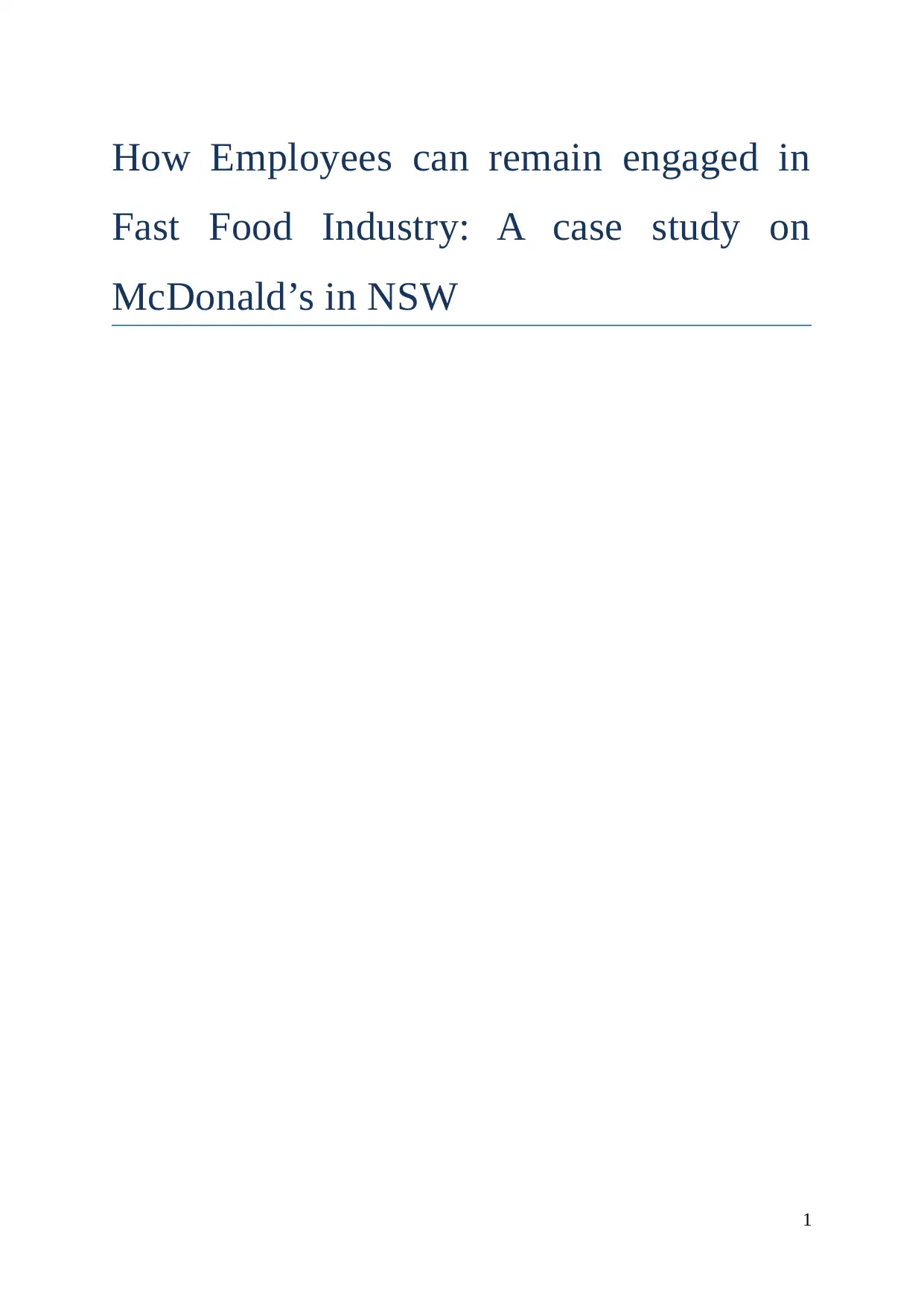
How Employees can remain engaged in
Fast Food Industry: A case study on
McDonald’s in NSW
1
Fast Food Industry: A case study on
McDonald’s in NSW
1
Paraphrase This Document
Need a fresh take? Get an instant paraphrase of this document with our AI Paraphraser
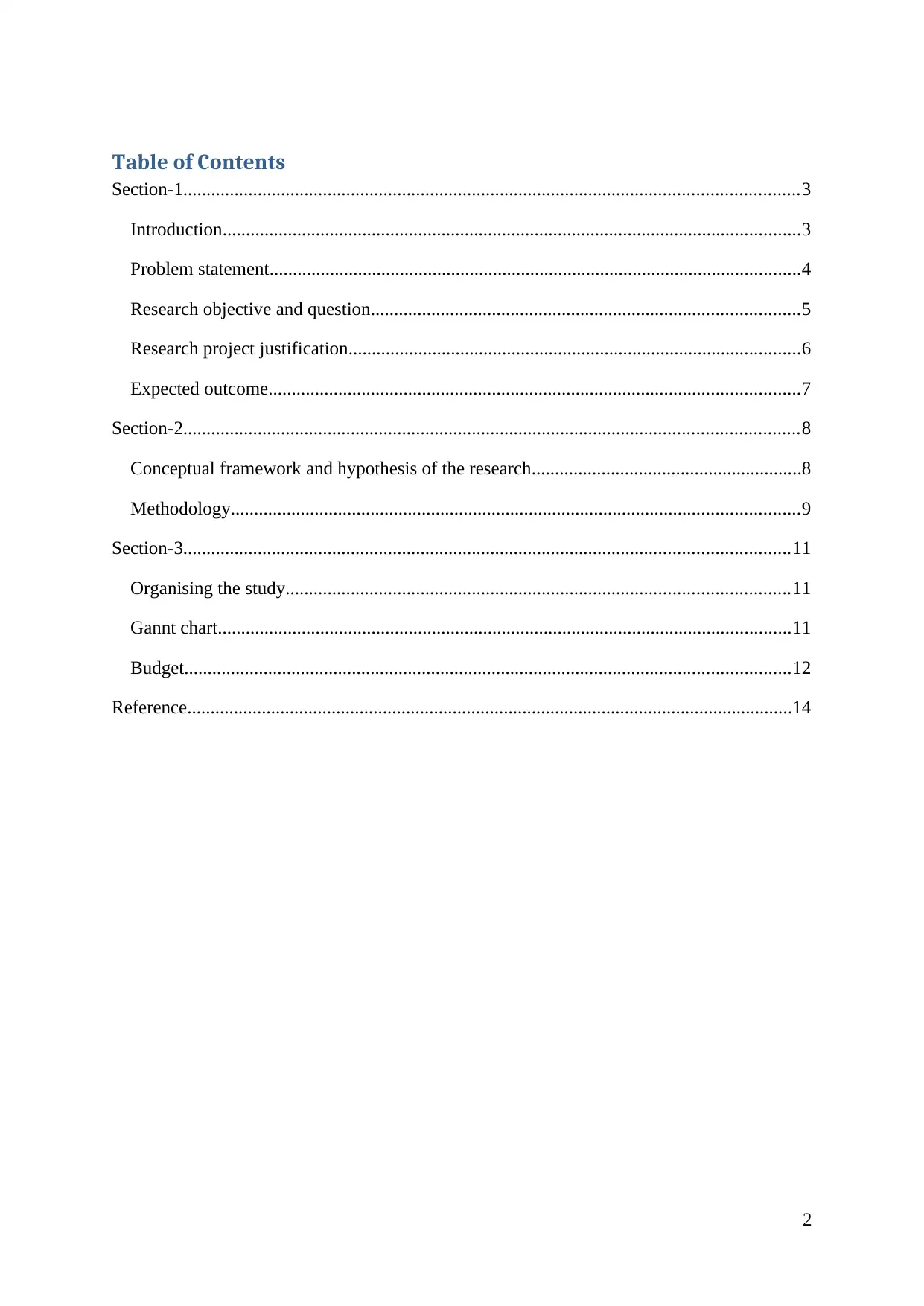
Table of Contents
Section-1....................................................................................................................................3
Introduction............................................................................................................................3
Problem statement..................................................................................................................4
Research objective and question............................................................................................5
Research project justification.................................................................................................6
Expected outcome..................................................................................................................7
Section-2....................................................................................................................................8
Conceptual framework and hypothesis of the research..........................................................8
Methodology..........................................................................................................................9
Section-3..................................................................................................................................11
Organising the study............................................................................................................11
Gannt chart...........................................................................................................................11
Budget..................................................................................................................................12
Reference..................................................................................................................................14
2
Section-1....................................................................................................................................3
Introduction............................................................................................................................3
Problem statement..................................................................................................................4
Research objective and question............................................................................................5
Research project justification.................................................................................................6
Expected outcome..................................................................................................................7
Section-2....................................................................................................................................8
Conceptual framework and hypothesis of the research..........................................................8
Methodology..........................................................................................................................9
Section-3..................................................................................................................................11
Organising the study............................................................................................................11
Gannt chart...........................................................................................................................11
Budget..................................................................................................................................12
Reference..................................................................................................................................14
2
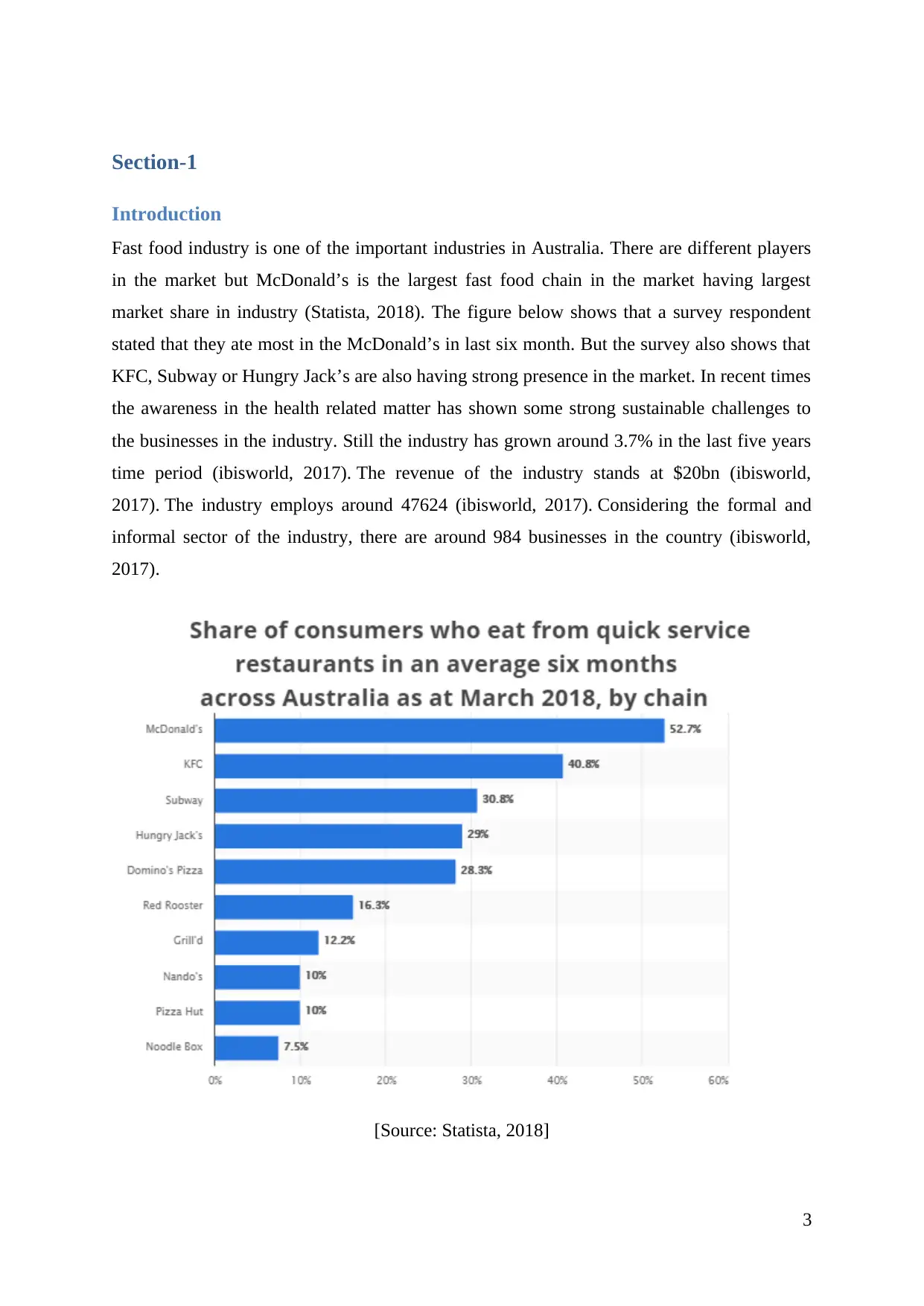
Section-1
Introduction
Fast food industry is one of the important industries in Australia. There are different players
in the market but McDonald’s is the largest fast food chain in the market having largest
market share in industry (Statista, 2018). The figure below shows that a survey respondent
stated that they ate most in the McDonald’s in last six month. But the survey also shows that
KFC, Subway or Hungry Jack’s are also having strong presence in the market. In recent times
the awareness in the health related matter has shown some strong sustainable challenges to
the businesses in the industry. Still the industry has grown around 3.7% in the last five years
time period (ibisworld, 2017). The revenue of the industry stands at $20bn (ibisworld,
2017). The industry employs around 47624 (ibisworld, 2017). Considering the formal and
informal sector of the industry, there are around 984 businesses in the country (ibisworld,
2017).
[Source: Statista, 2018]
3
Introduction
Fast food industry is one of the important industries in Australia. There are different players
in the market but McDonald’s is the largest fast food chain in the market having largest
market share in industry (Statista, 2018). The figure below shows that a survey respondent
stated that they ate most in the McDonald’s in last six month. But the survey also shows that
KFC, Subway or Hungry Jack’s are also having strong presence in the market. In recent times
the awareness in the health related matter has shown some strong sustainable challenges to
the businesses in the industry. Still the industry has grown around 3.7% in the last five years
time period (ibisworld, 2017). The revenue of the industry stands at $20bn (ibisworld,
2017). The industry employs around 47624 (ibisworld, 2017). Considering the formal and
informal sector of the industry, there are around 984 businesses in the country (ibisworld,
2017).
[Source: Statista, 2018]
3
⊘ This is a preview!⊘
Do you want full access?
Subscribe today to unlock all pages.

Trusted by 1+ million students worldwide
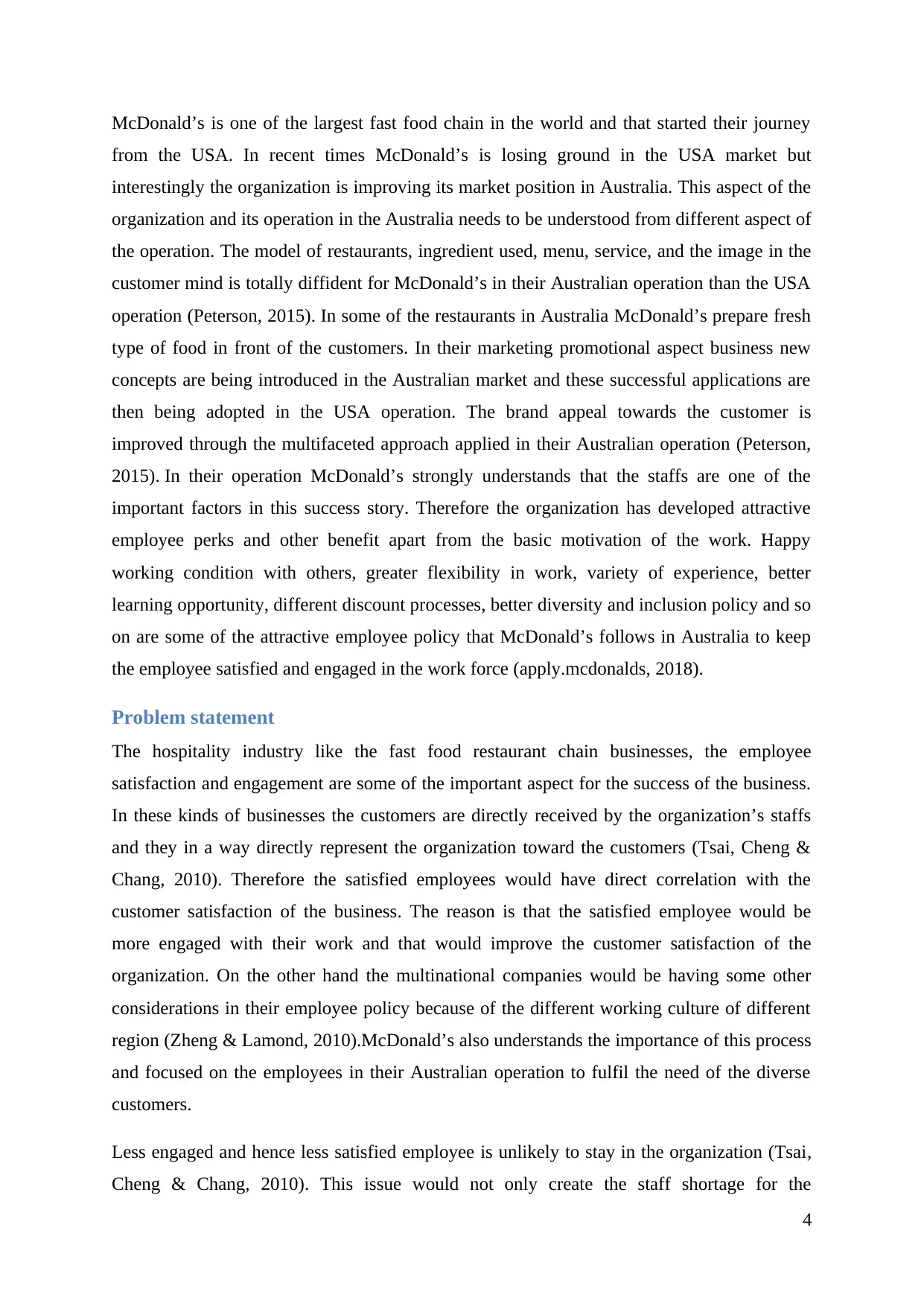
McDonald’s is one of the largest fast food chain in the world and that started their journey
from the USA. In recent times McDonald’s is losing ground in the USA market but
interestingly the organization is improving its market position in Australia. This aspect of the
organization and its operation in the Australia needs to be understood from different aspect of
the operation. The model of restaurants, ingredient used, menu, service, and the image in the
customer mind is totally diffident for McDonald’s in their Australian operation than the USA
operation (Peterson, 2015). In some of the restaurants in Australia McDonald’s prepare fresh
type of food in front of the customers. In their marketing promotional aspect business new
concepts are being introduced in the Australian market and these successful applications are
then being adopted in the USA operation. The brand appeal towards the customer is
improved through the multifaceted approach applied in their Australian operation (Peterson,
2015). In their operation McDonald’s strongly understands that the staffs are one of the
important factors in this success story. Therefore the organization has developed attractive
employee perks and other benefit apart from the basic motivation of the work. Happy
working condition with others, greater flexibility in work, variety of experience, better
learning opportunity, different discount processes, better diversity and inclusion policy and so
on are some of the attractive employee policy that McDonald’s follows in Australia to keep
the employee satisfied and engaged in the work force (apply.mcdonalds, 2018).
Problem statement
The hospitality industry like the fast food restaurant chain businesses, the employee
satisfaction and engagement are some of the important aspect for the success of the business.
In these kinds of businesses the customers are directly received by the organization’s staffs
and they in a way directly represent the organization toward the customers (Tsai, Cheng &
Chang, 2010). Therefore the satisfied employees would have direct correlation with the
customer satisfaction of the business. The reason is that the satisfied employee would be
more engaged with their work and that would improve the customer satisfaction of the
organization. On the other hand the multinational companies would be having some other
considerations in their employee policy because of the different working culture of different
region (Zheng & Lamond, 2010).McDonald’s also understands the importance of this process
and focused on the employees in their Australian operation to fulfil the need of the diverse
customers.
Less engaged and hence less satisfied employee is unlikely to stay in the organization (Tsai,
Cheng & Chang, 2010). This issue would not only create the staff shortage for the
4
from the USA. In recent times McDonald’s is losing ground in the USA market but
interestingly the organization is improving its market position in Australia. This aspect of the
organization and its operation in the Australia needs to be understood from different aspect of
the operation. The model of restaurants, ingredient used, menu, service, and the image in the
customer mind is totally diffident for McDonald’s in their Australian operation than the USA
operation (Peterson, 2015). In some of the restaurants in Australia McDonald’s prepare fresh
type of food in front of the customers. In their marketing promotional aspect business new
concepts are being introduced in the Australian market and these successful applications are
then being adopted in the USA operation. The brand appeal towards the customer is
improved through the multifaceted approach applied in their Australian operation (Peterson,
2015). In their operation McDonald’s strongly understands that the staffs are one of the
important factors in this success story. Therefore the organization has developed attractive
employee perks and other benefit apart from the basic motivation of the work. Happy
working condition with others, greater flexibility in work, variety of experience, better
learning opportunity, different discount processes, better diversity and inclusion policy and so
on are some of the attractive employee policy that McDonald’s follows in Australia to keep
the employee satisfied and engaged in the work force (apply.mcdonalds, 2018).
Problem statement
The hospitality industry like the fast food restaurant chain businesses, the employee
satisfaction and engagement are some of the important aspect for the success of the business.
In these kinds of businesses the customers are directly received by the organization’s staffs
and they in a way directly represent the organization toward the customers (Tsai, Cheng &
Chang, 2010). Therefore the satisfied employees would have direct correlation with the
customer satisfaction of the business. The reason is that the satisfied employee would be
more engaged with their work and that would improve the customer satisfaction of the
organization. On the other hand the multinational companies would be having some other
considerations in their employee policy because of the different working culture of different
region (Zheng & Lamond, 2010).McDonald’s also understands the importance of this process
and focused on the employees in their Australian operation to fulfil the need of the diverse
customers.
Less engaged and hence less satisfied employee is unlikely to stay in the organization (Tsai,
Cheng & Chang, 2010). This issue would not only create the staff shortage for the
4
Paraphrase This Document
Need a fresh take? Get an instant paraphrase of this document with our AI Paraphraser
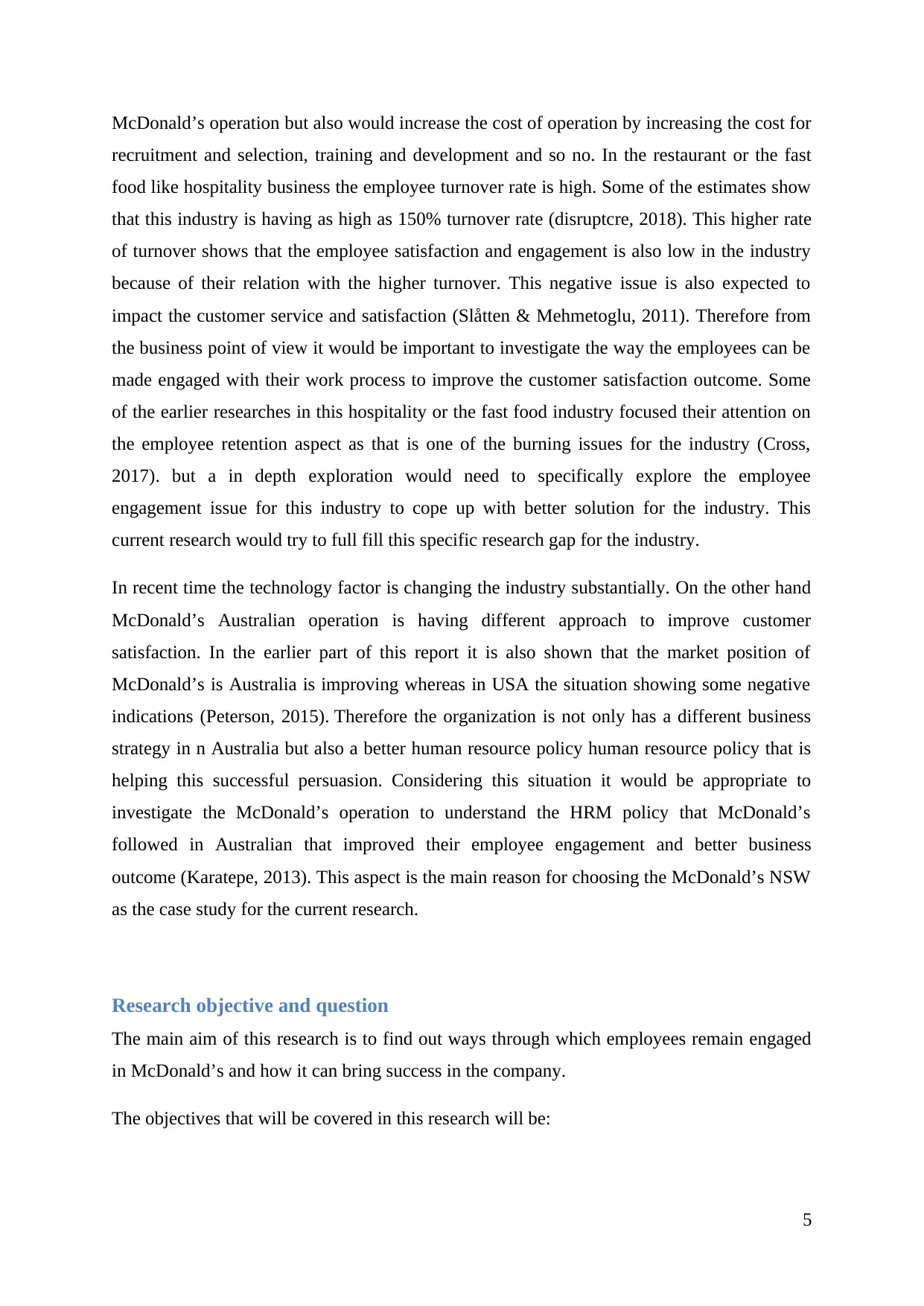
McDonald’s operation but also would increase the cost of operation by increasing the cost for
recruitment and selection, training and development and so no. In the restaurant or the fast
food like hospitality business the employee turnover rate is high. Some of the estimates show
that this industry is having as high as 150% turnover rate (disruptcre, 2018). This higher rate
of turnover shows that the employee satisfaction and engagement is also low in the industry
because of their relation with the higher turnover. This negative issue is also expected to
impact the customer service and satisfaction (Slåtten & Mehmetoglu, 2011). Therefore from
the business point of view it would be important to investigate the way the employees can be
made engaged with their work process to improve the customer satisfaction outcome. Some
of the earlier researches in this hospitality or the fast food industry focused their attention on
the employee retention aspect as that is one of the burning issues for the industry (Cross,
2017). but a in depth exploration would need to specifically explore the employee
engagement issue for this industry to cope up with better solution for the industry. This
current research would try to full fill this specific research gap for the industry.
In recent time the technology factor is changing the industry substantially. On the other hand
McDonald’s Australian operation is having different approach to improve customer
satisfaction. In the earlier part of this report it is also shown that the market position of
McDonald’s is Australia is improving whereas in USA the situation showing some negative
indications (Peterson, 2015). Therefore the organization is not only has a different business
strategy in n Australia but also a better human resource policy human resource policy that is
helping this successful persuasion. Considering this situation it would be appropriate to
investigate the McDonald’s operation to understand the HRM policy that McDonald’s
followed in Australian that improved their employee engagement and better business
outcome (Karatepe, 2013). This aspect is the main reason for choosing the McDonald’s NSW
as the case study for the current research.
Research objective and question
The main aim of this research is to find out ways through which employees remain engaged
in McDonald’s and how it can bring success in the company.
The objectives that will be covered in this research will be:
5
recruitment and selection, training and development and so no. In the restaurant or the fast
food like hospitality business the employee turnover rate is high. Some of the estimates show
that this industry is having as high as 150% turnover rate (disruptcre, 2018). This higher rate
of turnover shows that the employee satisfaction and engagement is also low in the industry
because of their relation with the higher turnover. This negative issue is also expected to
impact the customer service and satisfaction (Slåtten & Mehmetoglu, 2011). Therefore from
the business point of view it would be important to investigate the way the employees can be
made engaged with their work process to improve the customer satisfaction outcome. Some
of the earlier researches in this hospitality or the fast food industry focused their attention on
the employee retention aspect as that is one of the burning issues for the industry (Cross,
2017). but a in depth exploration would need to specifically explore the employee
engagement issue for this industry to cope up with better solution for the industry. This
current research would try to full fill this specific research gap for the industry.
In recent time the technology factor is changing the industry substantially. On the other hand
McDonald’s Australian operation is having different approach to improve customer
satisfaction. In the earlier part of this report it is also shown that the market position of
McDonald’s is Australia is improving whereas in USA the situation showing some negative
indications (Peterson, 2015). Therefore the organization is not only has a different business
strategy in n Australia but also a better human resource policy human resource policy that is
helping this successful persuasion. Considering this situation it would be appropriate to
investigate the McDonald’s operation to understand the HRM policy that McDonald’s
followed in Australian that improved their employee engagement and better business
outcome (Karatepe, 2013). This aspect is the main reason for choosing the McDonald’s NSW
as the case study for the current research.
Research objective and question
The main aim of this research is to find out ways through which employees remain engaged
in McDonald’s and how it can bring success in the company.
The objectives that will be covered in this research will be:
5
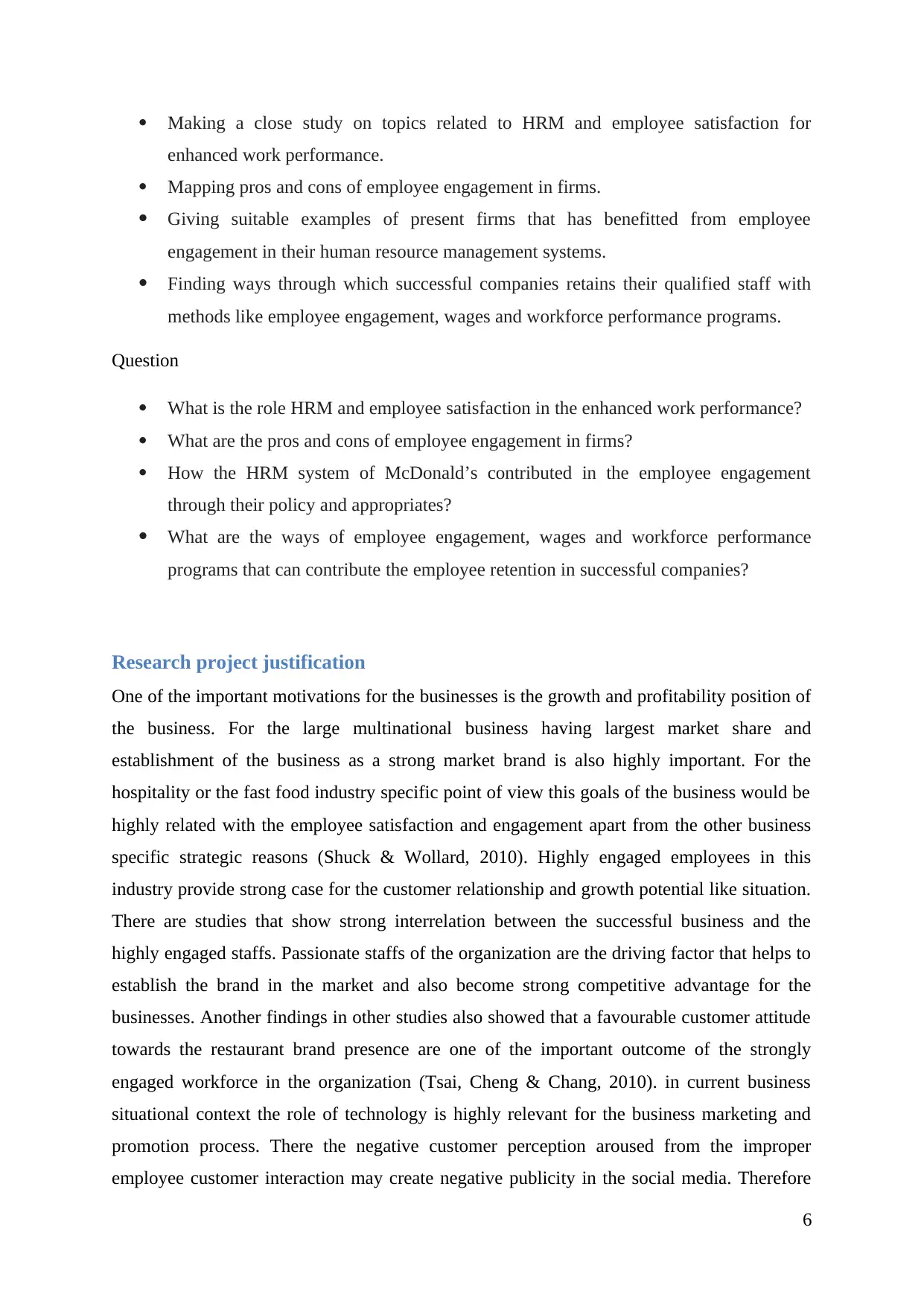
Making a close study on topics related to HRM and employee satisfaction for
enhanced work performance.
Mapping pros and cons of employee engagement in firms.
Giving suitable examples of present firms that has benefitted from employee
engagement in their human resource management systems.
Finding ways through which successful companies retains their qualified staff with
methods like employee engagement, wages and workforce performance programs.
Question
What is the role HRM and employee satisfaction in the enhanced work performance?
What are the pros and cons of employee engagement in firms?
How the HRM system of McDonald’s contributed in the employee engagement
through their policy and appropriates?
What are the ways of employee engagement, wages and workforce performance
programs that can contribute the employee retention in successful companies?
Research project justification
One of the important motivations for the businesses is the growth and profitability position of
the business. For the large multinational business having largest market share and
establishment of the business as a strong market brand is also highly important. For the
hospitality or the fast food industry specific point of view this goals of the business would be
highly related with the employee satisfaction and engagement apart from the other business
specific strategic reasons (Shuck & Wollard, 2010). Highly engaged employees in this
industry provide strong case for the customer relationship and growth potential like situation.
There are studies that show strong interrelation between the successful business and the
highly engaged staffs. Passionate staffs of the organization are the driving factor that helps to
establish the brand in the market and also become strong competitive advantage for the
businesses. Another findings in other studies also showed that a favourable customer attitude
towards the restaurant brand presence are one of the important outcome of the strongly
engaged workforce in the organization (Tsai, Cheng & Chang, 2010). in current business
situational context the role of technology is highly relevant for the business marketing and
promotion process. There the negative customer perception aroused from the improper
employee customer interaction may create negative publicity in the social media. Therefore
6
enhanced work performance.
Mapping pros and cons of employee engagement in firms.
Giving suitable examples of present firms that has benefitted from employee
engagement in their human resource management systems.
Finding ways through which successful companies retains their qualified staff with
methods like employee engagement, wages and workforce performance programs.
Question
What is the role HRM and employee satisfaction in the enhanced work performance?
What are the pros and cons of employee engagement in firms?
How the HRM system of McDonald’s contributed in the employee engagement
through their policy and appropriates?
What are the ways of employee engagement, wages and workforce performance
programs that can contribute the employee retention in successful companies?
Research project justification
One of the important motivations for the businesses is the growth and profitability position of
the business. For the large multinational business having largest market share and
establishment of the business as a strong market brand is also highly important. For the
hospitality or the fast food industry specific point of view this goals of the business would be
highly related with the employee satisfaction and engagement apart from the other business
specific strategic reasons (Shuck & Wollard, 2010). Highly engaged employees in this
industry provide strong case for the customer relationship and growth potential like situation.
There are studies that show strong interrelation between the successful business and the
highly engaged staffs. Passionate staffs of the organization are the driving factor that helps to
establish the brand in the market and also become strong competitive advantage for the
businesses. Another findings in other studies also showed that a favourable customer attitude
towards the restaurant brand presence are one of the important outcome of the strongly
engaged workforce in the organization (Tsai, Cheng & Chang, 2010). in current business
situational context the role of technology is highly relevant for the business marketing and
promotion process. There the negative customer perception aroused from the improper
employee customer interaction may create negative publicity in the social media. Therefore
6
⊘ This is a preview!⊘
Do you want full access?
Subscribe today to unlock all pages.

Trusted by 1+ million students worldwide
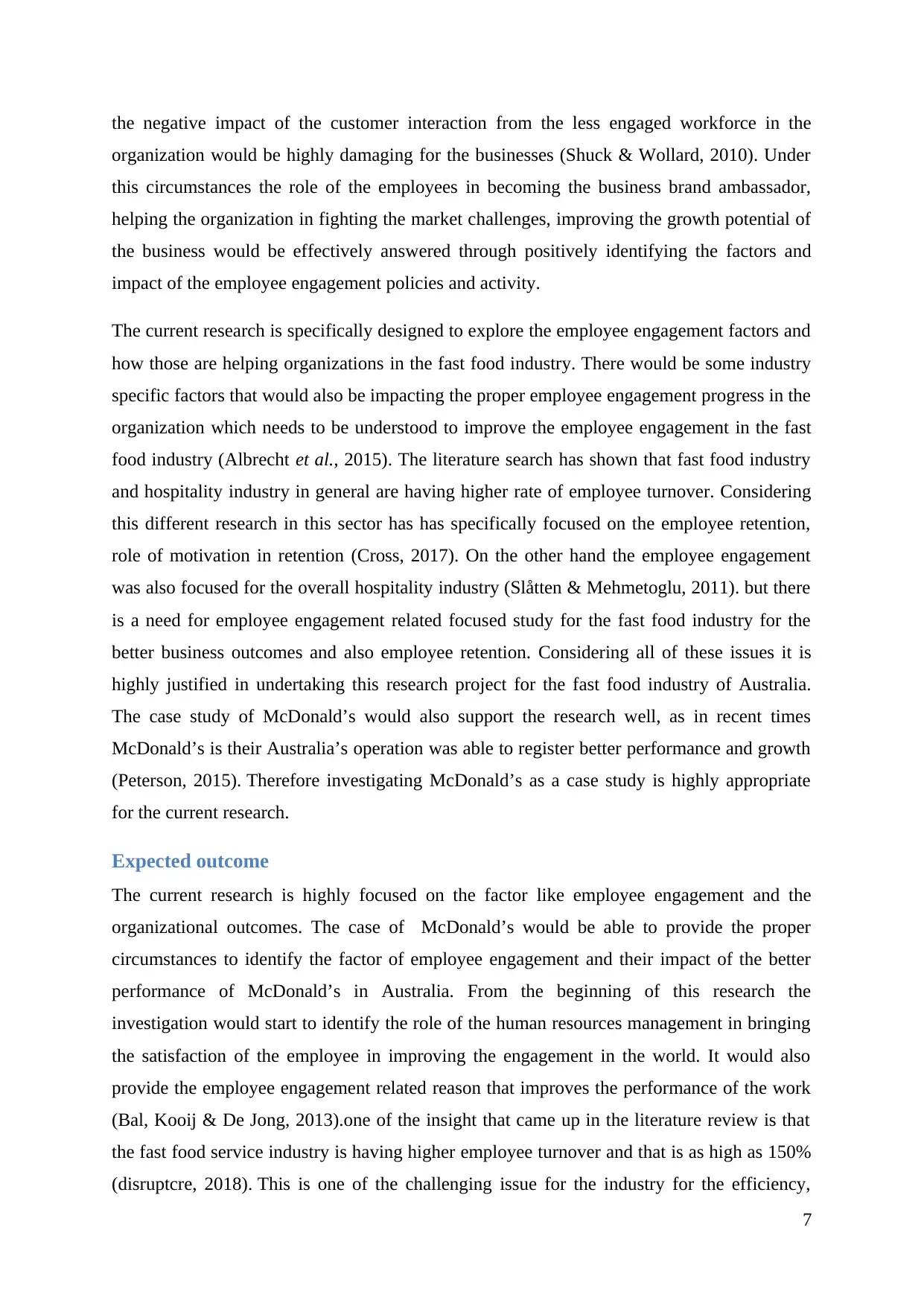
the negative impact of the customer interaction from the less engaged workforce in the
organization would be highly damaging for the businesses (Shuck & Wollard, 2010). Under
this circumstances the role of the employees in becoming the business brand ambassador,
helping the organization in fighting the market challenges, improving the growth potential of
the business would be effectively answered through positively identifying the factors and
impact of the employee engagement policies and activity.
The current research is specifically designed to explore the employee engagement factors and
how those are helping organizations in the fast food industry. There would be some industry
specific factors that would also be impacting the proper employee engagement progress in the
organization which needs to be understood to improve the employee engagement in the fast
food industry (Albrecht et al., 2015). The literature search has shown that fast food industry
and hospitality industry in general are having higher rate of employee turnover. Considering
this different research in this sector has has specifically focused on the employee retention,
role of motivation in retention (Cross, 2017). On the other hand the employee engagement
was also focused for the overall hospitality industry (Slåtten & Mehmetoglu, 2011). but there
is a need for employee engagement related focused study for the fast food industry for the
better business outcomes and also employee retention. Considering all of these issues it is
highly justified in undertaking this research project for the fast food industry of Australia.
The case study of McDonald’s would also support the research well, as in recent times
McDonald’s is their Australia’s operation was able to register better performance and growth
(Peterson, 2015). Therefore investigating McDonald’s as a case study is highly appropriate
for the current research.
Expected outcome
The current research is highly focused on the factor like employee engagement and the
organizational outcomes. The case of McDonald’s would be able to provide the proper
circumstances to identify the factor of employee engagement and their impact of the better
performance of McDonald’s in Australia. From the beginning of this research the
investigation would start to identify the role of the human resources management in bringing
the satisfaction of the employee in improving the engagement in the world. It would also
provide the employee engagement related reason that improves the performance of the work
(Bal, Kooij & De Jong, 2013).one of the insight that came up in the literature review is that
the fast food service industry is having higher employee turnover and that is as high as 150%
(disruptcre, 2018). This is one of the challenging issue for the industry for the efficiency,
7
organization would be highly damaging for the businesses (Shuck & Wollard, 2010). Under
this circumstances the role of the employees in becoming the business brand ambassador,
helping the organization in fighting the market challenges, improving the growth potential of
the business would be effectively answered through positively identifying the factors and
impact of the employee engagement policies and activity.
The current research is specifically designed to explore the employee engagement factors and
how those are helping organizations in the fast food industry. There would be some industry
specific factors that would also be impacting the proper employee engagement progress in the
organization which needs to be understood to improve the employee engagement in the fast
food industry (Albrecht et al., 2015). The literature search has shown that fast food industry
and hospitality industry in general are having higher rate of employee turnover. Considering
this different research in this sector has has specifically focused on the employee retention,
role of motivation in retention (Cross, 2017). On the other hand the employee engagement
was also focused for the overall hospitality industry (Slåtten & Mehmetoglu, 2011). but there
is a need for employee engagement related focused study for the fast food industry for the
better business outcomes and also employee retention. Considering all of these issues it is
highly justified in undertaking this research project for the fast food industry of Australia.
The case study of McDonald’s would also support the research well, as in recent times
McDonald’s is their Australia’s operation was able to register better performance and growth
(Peterson, 2015). Therefore investigating McDonald’s as a case study is highly appropriate
for the current research.
Expected outcome
The current research is highly focused on the factor like employee engagement and the
organizational outcomes. The case of McDonald’s would be able to provide the proper
circumstances to identify the factor of employee engagement and their impact of the better
performance of McDonald’s in Australia. From the beginning of this research the
investigation would start to identify the role of the human resources management in bringing
the satisfaction of the employee in improving the engagement in the world. It would also
provide the employee engagement related reason that improves the performance of the work
(Bal, Kooij & De Jong, 2013).one of the insight that came up in the literature review is that
the fast food service industry is having higher employee turnover and that is as high as 150%
(disruptcre, 2018). This is one of the challenging issue for the industry for the efficiency,
7
Paraphrase This Document
Need a fresh take? Get an instant paraphrase of this document with our AI Paraphraser
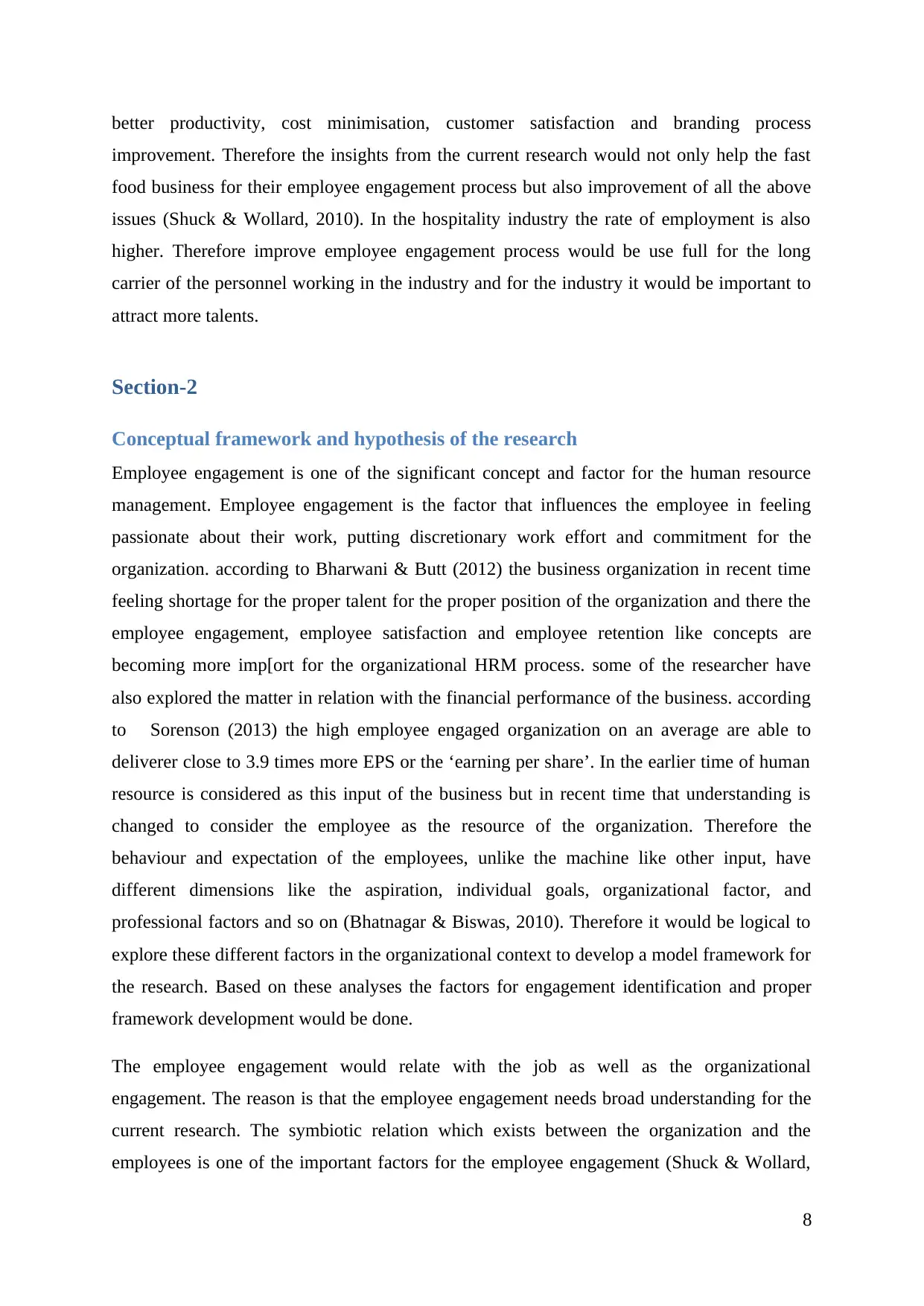
better productivity, cost minimisation, customer satisfaction and branding process
improvement. Therefore the insights from the current research would not only help the fast
food business for their employee engagement process but also improvement of all the above
issues (Shuck & Wollard, 2010). In the hospitality industry the rate of employment is also
higher. Therefore improve employee engagement process would be use full for the long
carrier of the personnel working in the industry and for the industry it would be important to
attract more talents.
Section-2
Conceptual framework and hypothesis of the research
Employee engagement is one of the significant concept and factor for the human resource
management. Employee engagement is the factor that influences the employee in feeling
passionate about their work, putting discretionary work effort and commitment for the
organization. according to Bharwani & Butt (2012) the business organization in recent time
feeling shortage for the proper talent for the proper position of the organization and there the
employee engagement, employee satisfaction and employee retention like concepts are
becoming more imp[ort for the organizational HRM process. some of the researcher have
also explored the matter in relation with the financial performance of the business. according
to Sorenson (2013) the high employee engaged organization on an average are able to
deliverer close to 3.9 times more EPS or the ‘earning per share’. In the earlier time of human
resource is considered as this input of the business but in recent time that understanding is
changed to consider the employee as the resource of the organization. Therefore the
behaviour and expectation of the employees, unlike the machine like other input, have
different dimensions like the aspiration, individual goals, organizational factor, and
professional factors and so on (Bhatnagar & Biswas, 2010). Therefore it would be logical to
explore these different factors in the organizational context to develop a model framework for
the research. Based on these analyses the factors for engagement identification and proper
framework development would be done.
The employee engagement would relate with the job as well as the organizational
engagement. The reason is that the employee engagement needs broad understanding for the
current research. The symbiotic relation which exists between the organization and the
employees is one of the important factors for the employee engagement (Shuck & Wollard,
8
improvement. Therefore the insights from the current research would not only help the fast
food business for their employee engagement process but also improvement of all the above
issues (Shuck & Wollard, 2010). In the hospitality industry the rate of employment is also
higher. Therefore improve employee engagement process would be use full for the long
carrier of the personnel working in the industry and for the industry it would be important to
attract more talents.
Section-2
Conceptual framework and hypothesis of the research
Employee engagement is one of the significant concept and factor for the human resource
management. Employee engagement is the factor that influences the employee in feeling
passionate about their work, putting discretionary work effort and commitment for the
organization. according to Bharwani & Butt (2012) the business organization in recent time
feeling shortage for the proper talent for the proper position of the organization and there the
employee engagement, employee satisfaction and employee retention like concepts are
becoming more imp[ort for the organizational HRM process. some of the researcher have
also explored the matter in relation with the financial performance of the business. according
to Sorenson (2013) the high employee engaged organization on an average are able to
deliverer close to 3.9 times more EPS or the ‘earning per share’. In the earlier time of human
resource is considered as this input of the business but in recent time that understanding is
changed to consider the employee as the resource of the organization. Therefore the
behaviour and expectation of the employees, unlike the machine like other input, have
different dimensions like the aspiration, individual goals, organizational factor, and
professional factors and so on (Bhatnagar & Biswas, 2010). Therefore it would be logical to
explore these different factors in the organizational context to develop a model framework for
the research. Based on these analyses the factors for engagement identification and proper
framework development would be done.
The employee engagement would relate with the job as well as the organizational
engagement. The reason is that the employee engagement needs broad understanding for the
current research. The symbiotic relation which exists between the organization and the
employees is one of the important factors for the employee engagement (Shuck & Wollard,
8
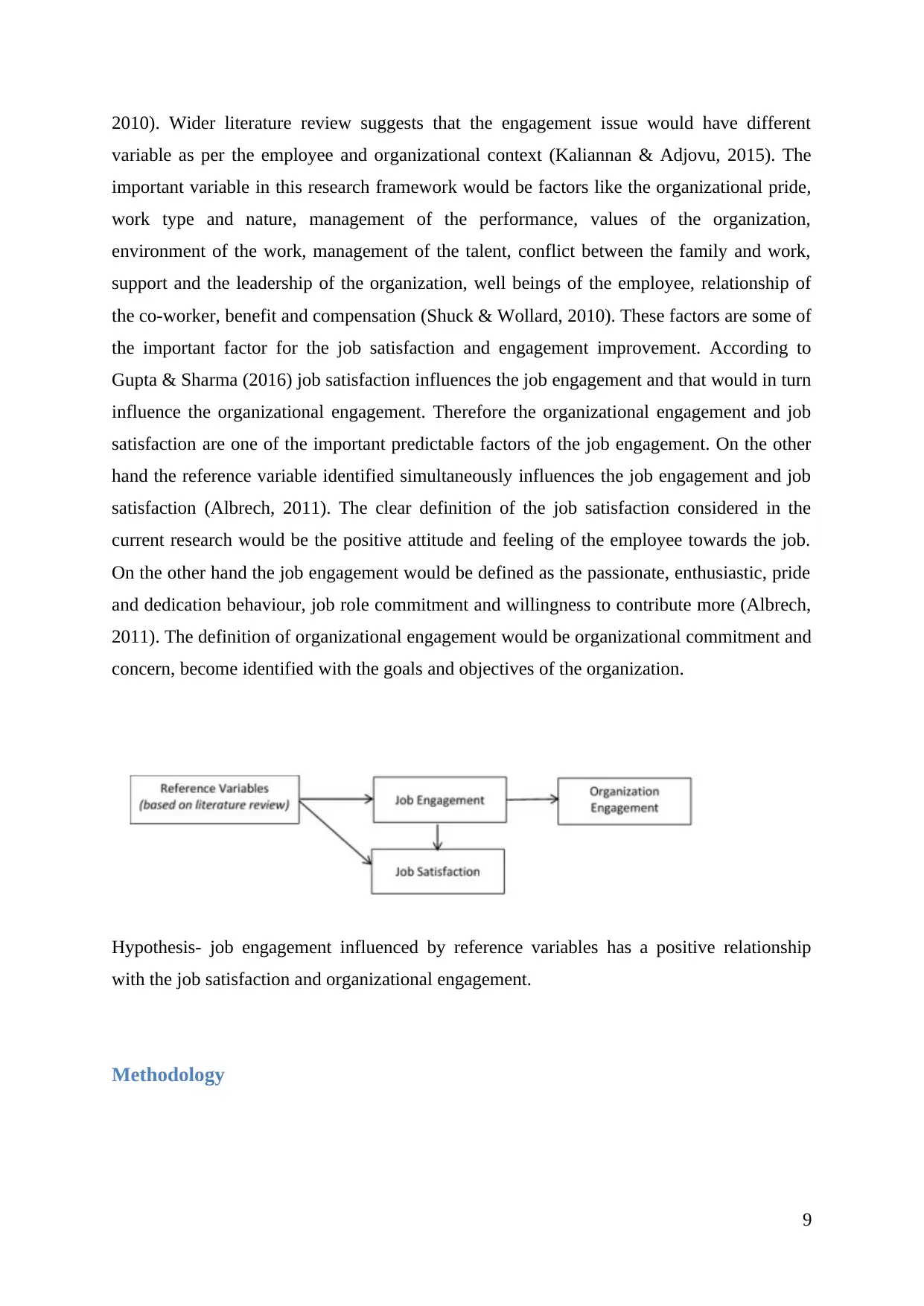
2010). Wider literature review suggests that the engagement issue would have different
variable as per the employee and organizational context (Kaliannan & Adjovu, 2015). The
important variable in this research framework would be factors like the organizational pride,
work type and nature, management of the performance, values of the organization,
environment of the work, management of the talent, conflict between the family and work,
support and the leadership of the organization, well beings of the employee, relationship of
the co-worker, benefit and compensation (Shuck & Wollard, 2010). These factors are some of
the important factor for the job satisfaction and engagement improvement. According to
Gupta & Sharma (2016) job satisfaction influences the job engagement and that would in turn
influence the organizational engagement. Therefore the organizational engagement and job
satisfaction are one of the important predictable factors of the job engagement. On the other
hand the reference variable identified simultaneously influences the job engagement and job
satisfaction (Albrech, 2011). The clear definition of the job satisfaction considered in the
current research would be the positive attitude and feeling of the employee towards the job.
On the other hand the job engagement would be defined as the passionate, enthusiastic, pride
and dedication behaviour, job role commitment and willingness to contribute more (Albrech,
2011). The definition of organizational engagement would be organizational commitment and
concern, become identified with the goals and objectives of the organization.
Hypothesis- job engagement influenced by reference variables has a positive relationship
with the job satisfaction and organizational engagement.
Methodology
9
variable as per the employee and organizational context (Kaliannan & Adjovu, 2015). The
important variable in this research framework would be factors like the organizational pride,
work type and nature, management of the performance, values of the organization,
environment of the work, management of the talent, conflict between the family and work,
support and the leadership of the organization, well beings of the employee, relationship of
the co-worker, benefit and compensation (Shuck & Wollard, 2010). These factors are some of
the important factor for the job satisfaction and engagement improvement. According to
Gupta & Sharma (2016) job satisfaction influences the job engagement and that would in turn
influence the organizational engagement. Therefore the organizational engagement and job
satisfaction are one of the important predictable factors of the job engagement. On the other
hand the reference variable identified simultaneously influences the job engagement and job
satisfaction (Albrech, 2011). The clear definition of the job satisfaction considered in the
current research would be the positive attitude and feeling of the employee towards the job.
On the other hand the job engagement would be defined as the passionate, enthusiastic, pride
and dedication behaviour, job role commitment and willingness to contribute more (Albrech,
2011). The definition of organizational engagement would be organizational commitment and
concern, become identified with the goals and objectives of the organization.
Hypothesis- job engagement influenced by reference variables has a positive relationship
with the job satisfaction and organizational engagement.
Methodology
9
⊘ This is a preview!⊘
Do you want full access?
Subscribe today to unlock all pages.

Trusted by 1+ million students worldwide
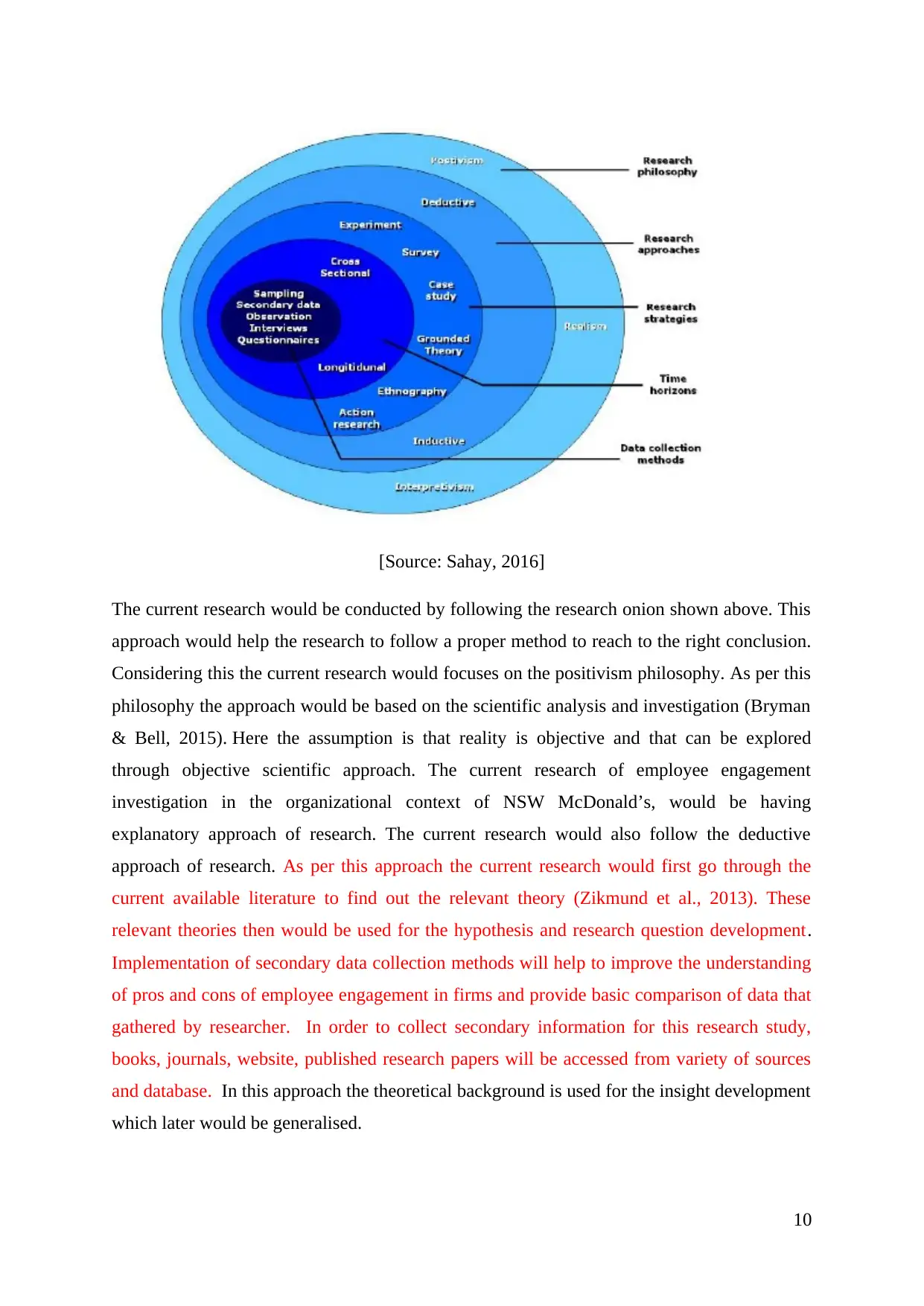
[Source: Sahay, 2016]
The current research would be conducted by following the research onion shown above. This
approach would help the research to follow a proper method to reach to the right conclusion.
Considering this the current research would focuses on the positivism philosophy. As per this
philosophy the approach would be based on the scientific analysis and investigation (Bryman
& Bell, 2015). Here the assumption is that reality is objective and that can be explored
through objective scientific approach. The current research of employee engagement
investigation in the organizational context of NSW McDonald’s, would be having
explanatory approach of research. The current research would also follow the deductive
approach of research. As per this approach the current research would first go through the
current available literature to find out the relevant theory (Zikmund et al., 2013). These
relevant theories then would be used for the hypothesis and research question development.
Implementation of secondary data collection methods will help to improve the understanding
of pros and cons of employee engagement in firms and provide basic comparison of data that
gathered by researcher. In order to collect secondary information for this research study,
books, journals, website, published research papers will be accessed from variety of sources
and database. In this approach the theoretical background is used for the insight development
which later would be generalised.
10
The current research would be conducted by following the research onion shown above. This
approach would help the research to follow a proper method to reach to the right conclusion.
Considering this the current research would focuses on the positivism philosophy. As per this
philosophy the approach would be based on the scientific analysis and investigation (Bryman
& Bell, 2015). Here the assumption is that reality is objective and that can be explored
through objective scientific approach. The current research of employee engagement
investigation in the organizational context of NSW McDonald’s, would be having
explanatory approach of research. The current research would also follow the deductive
approach of research. As per this approach the current research would first go through the
current available literature to find out the relevant theory (Zikmund et al., 2013). These
relevant theories then would be used for the hypothesis and research question development.
Implementation of secondary data collection methods will help to improve the understanding
of pros and cons of employee engagement in firms and provide basic comparison of data that
gathered by researcher. In order to collect secondary information for this research study,
books, journals, website, published research papers will be accessed from variety of sources
and database. In this approach the theoretical background is used for the insight development
which later would be generalised.
10
Paraphrase This Document
Need a fresh take? Get an instant paraphrase of this document with our AI Paraphraser
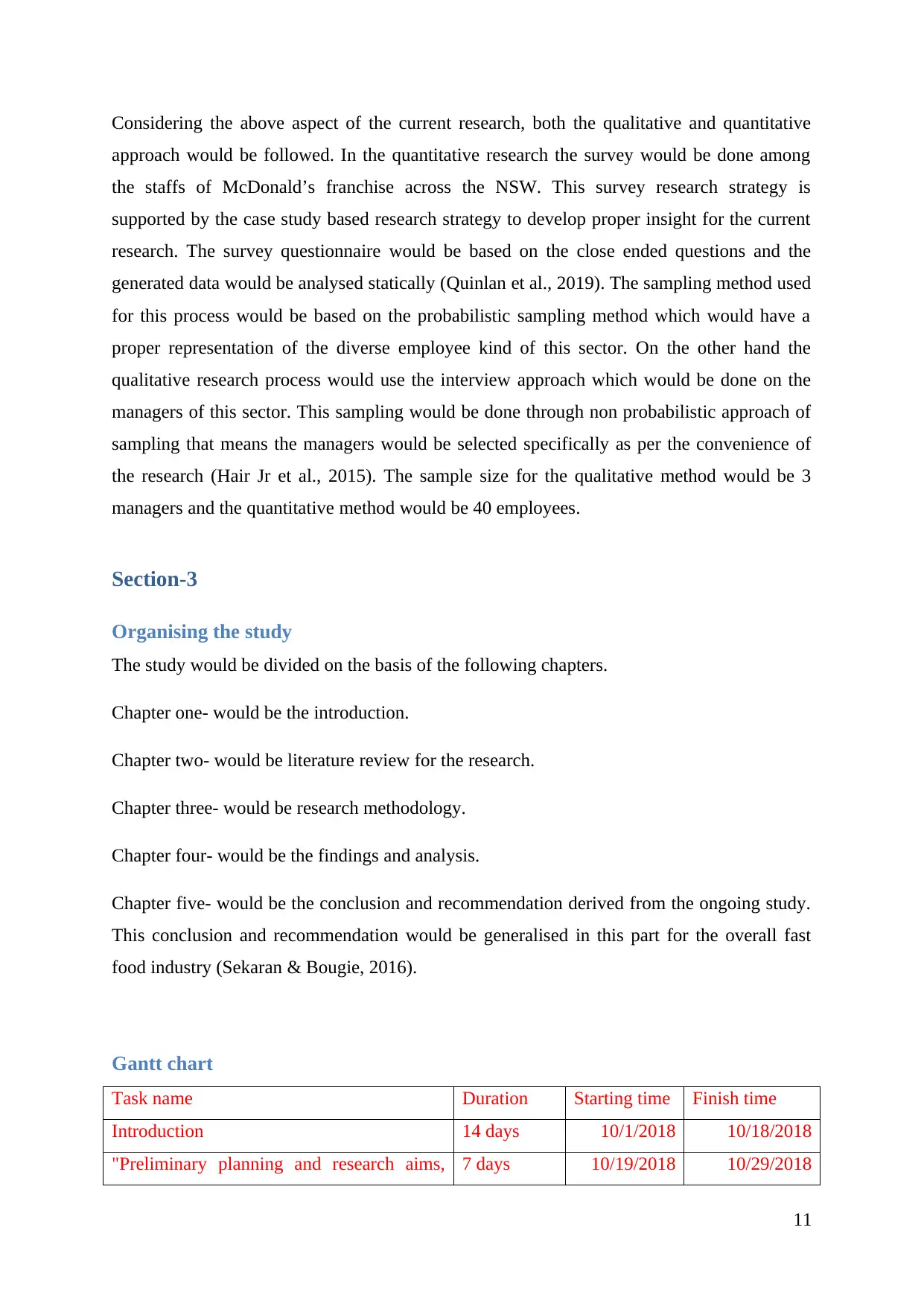
Considering the above aspect of the current research, both the qualitative and quantitative
approach would be followed. In the quantitative research the survey would be done among
the staffs of McDonald’s franchise across the NSW. This survey research strategy is
supported by the case study based research strategy to develop proper insight for the current
research. The survey questionnaire would be based on the close ended questions and the
generated data would be analysed statically (Quinlan et al., 2019). The sampling method used
for this process would be based on the probabilistic sampling method which would have a
proper representation of the diverse employee kind of this sector. On the other hand the
qualitative research process would use the interview approach which would be done on the
managers of this sector. This sampling would be done through non probabilistic approach of
sampling that means the managers would be selected specifically as per the convenience of
the research (Hair Jr et al., 2015). The sample size for the qualitative method would be 3
managers and the quantitative method would be 40 employees.
Section-3
Organising the study
The study would be divided on the basis of the following chapters.
Chapter one- would be the introduction.
Chapter two- would be literature review for the research.
Chapter three- would be research methodology.
Chapter four- would be the findings and analysis.
Chapter five- would be the conclusion and recommendation derived from the ongoing study.
This conclusion and recommendation would be generalised in this part for the overall fast
food industry (Sekaran & Bougie, 2016).
Gantt chart
Task name Duration Starting time Finish time
Introduction 14 days 10/1/2018 10/18/2018
"Preliminary planning and research aims, 7 days 10/19/2018 10/29/2018
11
approach would be followed. In the quantitative research the survey would be done among
the staffs of McDonald’s franchise across the NSW. This survey research strategy is
supported by the case study based research strategy to develop proper insight for the current
research. The survey questionnaire would be based on the close ended questions and the
generated data would be analysed statically (Quinlan et al., 2019). The sampling method used
for this process would be based on the probabilistic sampling method which would have a
proper representation of the diverse employee kind of this sector. On the other hand the
qualitative research process would use the interview approach which would be done on the
managers of this sector. This sampling would be done through non probabilistic approach of
sampling that means the managers would be selected specifically as per the convenience of
the research (Hair Jr et al., 2015). The sample size for the qualitative method would be 3
managers and the quantitative method would be 40 employees.
Section-3
Organising the study
The study would be divided on the basis of the following chapters.
Chapter one- would be the introduction.
Chapter two- would be literature review for the research.
Chapter three- would be research methodology.
Chapter four- would be the findings and analysis.
Chapter five- would be the conclusion and recommendation derived from the ongoing study.
This conclusion and recommendation would be generalised in this part for the overall fast
food industry (Sekaran & Bougie, 2016).
Gantt chart
Task name Duration Starting time Finish time
Introduction 14 days 10/1/2018 10/18/2018
"Preliminary planning and research aims, 7 days 10/19/2018 10/29/2018
11
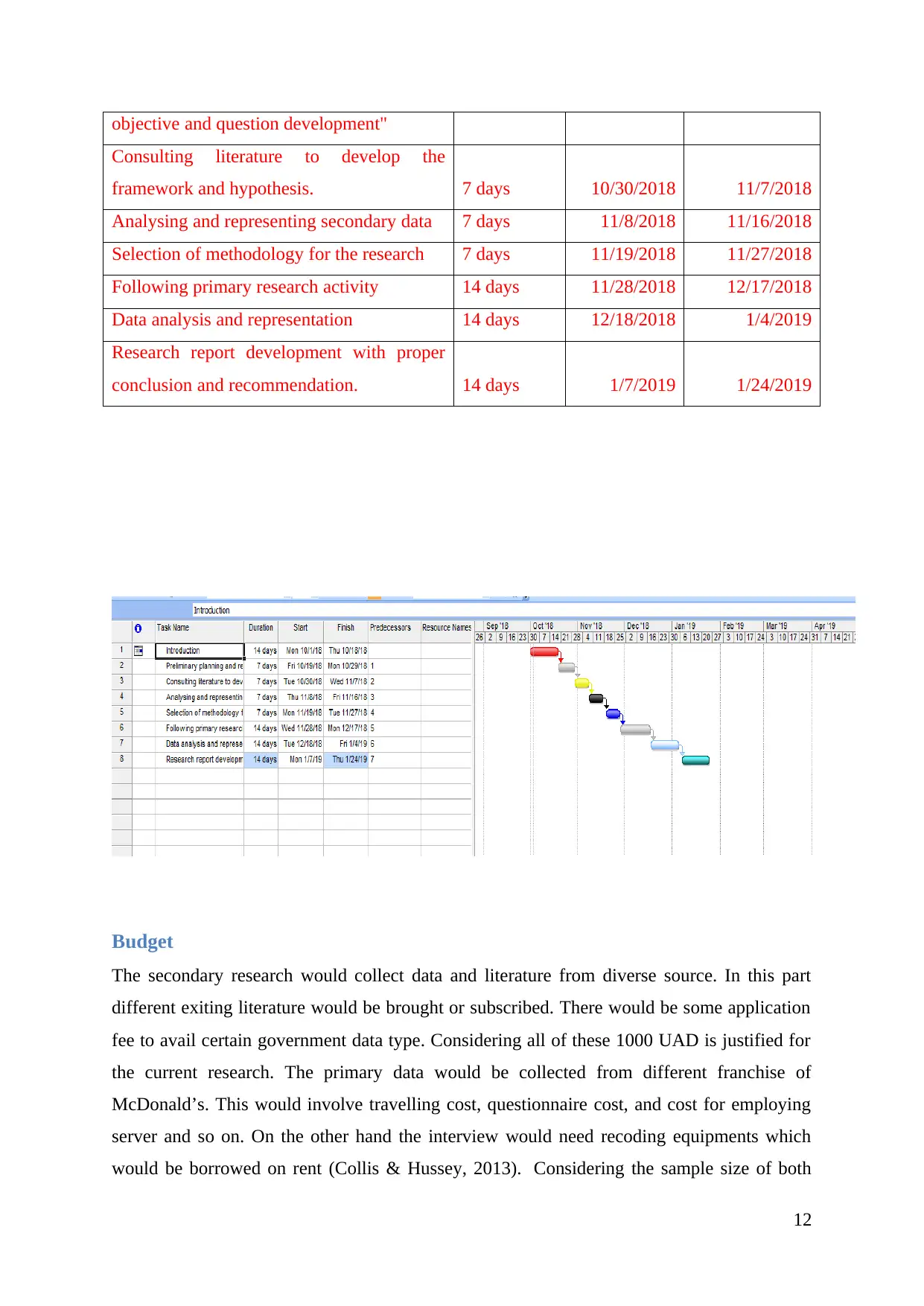
objective and question development"
Consulting literature to develop the
framework and hypothesis. 7 days 10/30/2018 11/7/2018
Analysing and representing secondary data 7 days 11/8/2018 11/16/2018
Selection of methodology for the research 7 days 11/19/2018 11/27/2018
Following primary research activity 14 days 11/28/2018 12/17/2018
Data analysis and representation 14 days 12/18/2018 1/4/2019
Research report development with proper
conclusion and recommendation. 14 days 1/7/2019 1/24/2019
Budget
The secondary research would collect data and literature from diverse source. In this part
different exiting literature would be brought or subscribed. There would be some application
fee to avail certain government data type. Considering all of these 1000 UAD is justified for
the current research. The primary data would be collected from different franchise of
McDonald’s. This would involve travelling cost, questionnaire cost, and cost for employing
server and so on. On the other hand the interview would need recoding equipments which
would be borrowed on rent (Collis & Hussey, 2013). Considering the sample size of both
12
Consulting literature to develop the
framework and hypothesis. 7 days 10/30/2018 11/7/2018
Analysing and representing secondary data 7 days 11/8/2018 11/16/2018
Selection of methodology for the research 7 days 11/19/2018 11/27/2018
Following primary research activity 14 days 11/28/2018 12/17/2018
Data analysis and representation 14 days 12/18/2018 1/4/2019
Research report development with proper
conclusion and recommendation. 14 days 1/7/2019 1/24/2019
Budget
The secondary research would collect data and literature from diverse source. In this part
different exiting literature would be brought or subscribed. There would be some application
fee to avail certain government data type. Considering all of these 1000 UAD is justified for
the current research. The primary data would be collected from different franchise of
McDonald’s. This would involve travelling cost, questionnaire cost, and cost for employing
server and so on. On the other hand the interview would need recoding equipments which
would be borrowed on rent (Collis & Hussey, 2013). Considering the sample size of both
12
⊘ This is a preview!⊘
Do you want full access?
Subscribe today to unlock all pages.

Trusted by 1+ million students worldwide
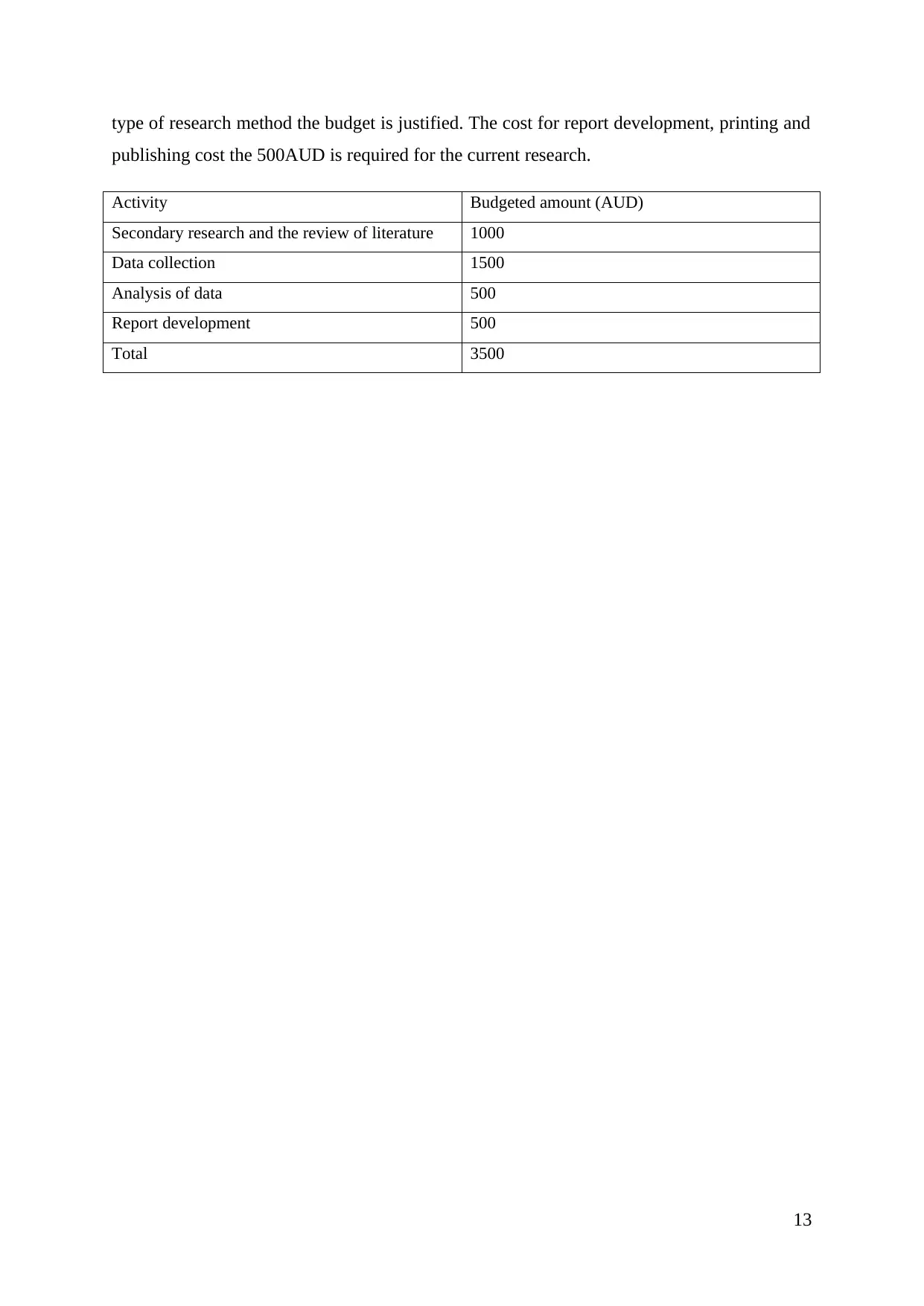
type of research method the budget is justified. The cost for report development, printing and
publishing cost the 500AUD is required for the current research.
Activity Budgeted amount (AUD)
Secondary research and the review of literature 1000
Data collection 1500
Analysis of data 500
Report development 500
Total 3500
13
publishing cost the 500AUD is required for the current research.
Activity Budgeted amount (AUD)
Secondary research and the review of literature 1000
Data collection 1500
Analysis of data 500
Report development 500
Total 3500
13
Paraphrase This Document
Need a fresh take? Get an instant paraphrase of this document with our AI Paraphraser
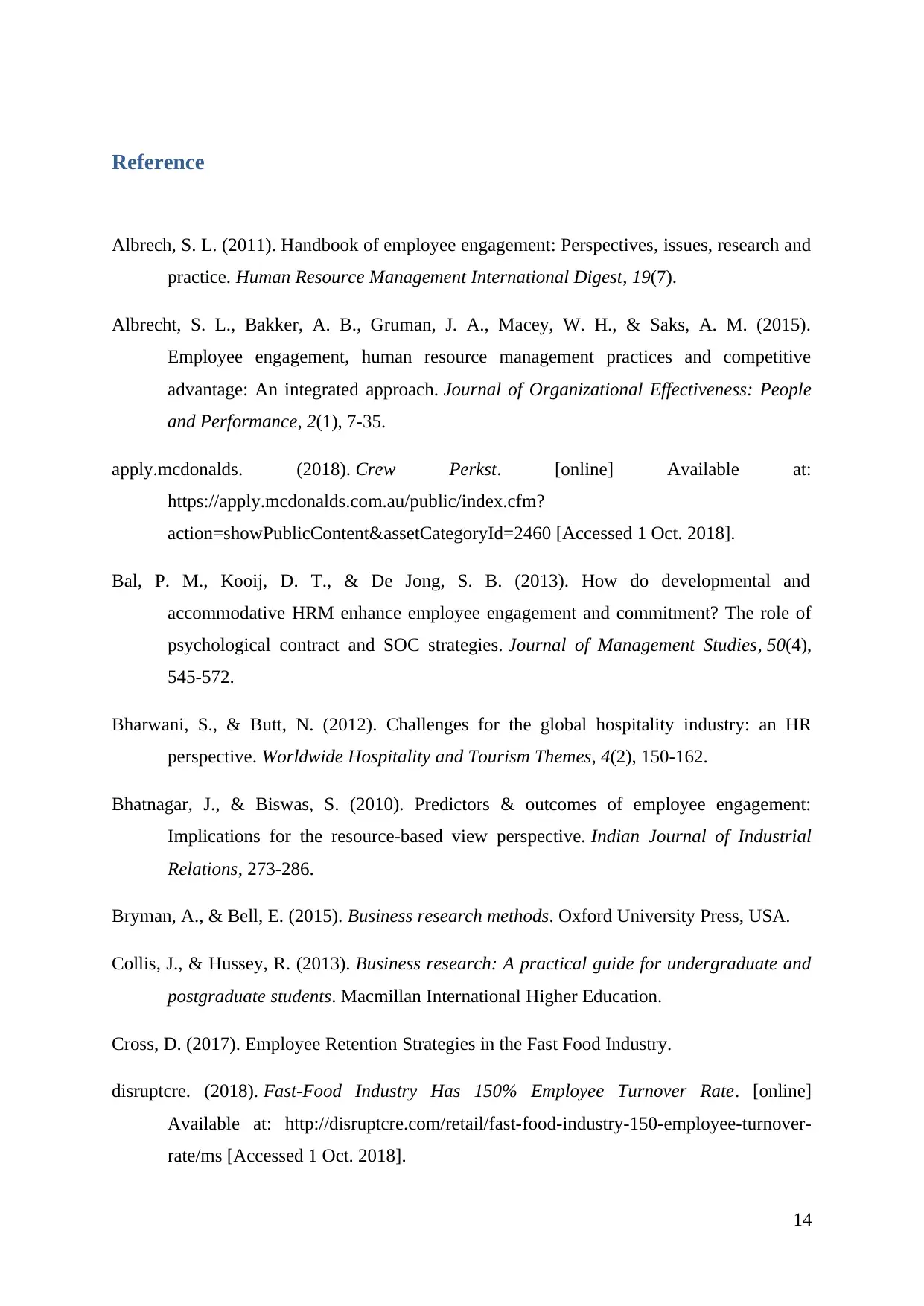
Reference
Albrech, S. L. (2011). Handbook of employee engagement: Perspectives, issues, research and
practice. Human Resource Management International Digest, 19(7).
Albrecht, S. L., Bakker, A. B., Gruman, J. A., Macey, W. H., & Saks, A. M. (2015).
Employee engagement, human resource management practices and competitive
advantage: An integrated approach. Journal of Organizational Effectiveness: People
and Performance, 2(1), 7-35.
apply.mcdonalds. (2018). Crew Perkst. [online] Available at:
https://apply.mcdonalds.com.au/public/index.cfm?
action=showPublicContent&assetCategoryId=2460 [Accessed 1 Oct. 2018].
Bal, P. M., Kooij, D. T., & De Jong, S. B. (2013). How do developmental and
accommodative HRM enhance employee engagement and commitment? The role of
psychological contract and SOC strategies. Journal of Management Studies, 50(4),
545-572.
Bharwani, S., & Butt, N. (2012). Challenges for the global hospitality industry: an HR
perspective. Worldwide Hospitality and Tourism Themes, 4(2), 150-162.
Bhatnagar, J., & Biswas, S. (2010). Predictors & outcomes of employee engagement:
Implications for the resource-based view perspective. Indian Journal of Industrial
Relations, 273-286.
Bryman, A., & Bell, E. (2015). Business research methods. Oxford University Press, USA.
Collis, J., & Hussey, R. (2013). Business research: A practical guide for undergraduate and
postgraduate students. Macmillan International Higher Education.
Cross, D. (2017). Employee Retention Strategies in the Fast Food Industry.
disruptcre. (2018). Fast-Food Industry Has 150% Employee Turnover Rate. [online]
Available at: http://disruptcre.com/retail/fast-food-industry-150-employee-turnover-
rate/ms [Accessed 1 Oct. 2018].
14
Albrech, S. L. (2011). Handbook of employee engagement: Perspectives, issues, research and
practice. Human Resource Management International Digest, 19(7).
Albrecht, S. L., Bakker, A. B., Gruman, J. A., Macey, W. H., & Saks, A. M. (2015).
Employee engagement, human resource management practices and competitive
advantage: An integrated approach. Journal of Organizational Effectiveness: People
and Performance, 2(1), 7-35.
apply.mcdonalds. (2018). Crew Perkst. [online] Available at:
https://apply.mcdonalds.com.au/public/index.cfm?
action=showPublicContent&assetCategoryId=2460 [Accessed 1 Oct. 2018].
Bal, P. M., Kooij, D. T., & De Jong, S. B. (2013). How do developmental and
accommodative HRM enhance employee engagement and commitment? The role of
psychological contract and SOC strategies. Journal of Management Studies, 50(4),
545-572.
Bharwani, S., & Butt, N. (2012). Challenges for the global hospitality industry: an HR
perspective. Worldwide Hospitality and Tourism Themes, 4(2), 150-162.
Bhatnagar, J., & Biswas, S. (2010). Predictors & outcomes of employee engagement:
Implications for the resource-based view perspective. Indian Journal of Industrial
Relations, 273-286.
Bryman, A., & Bell, E. (2015). Business research methods. Oxford University Press, USA.
Collis, J., & Hussey, R. (2013). Business research: A practical guide for undergraduate and
postgraduate students. Macmillan International Higher Education.
Cross, D. (2017). Employee Retention Strategies in the Fast Food Industry.
disruptcre. (2018). Fast-Food Industry Has 150% Employee Turnover Rate. [online]
Available at: http://disruptcre.com/retail/fast-food-industry-150-employee-turnover-
rate/ms [Accessed 1 Oct. 2018].
14
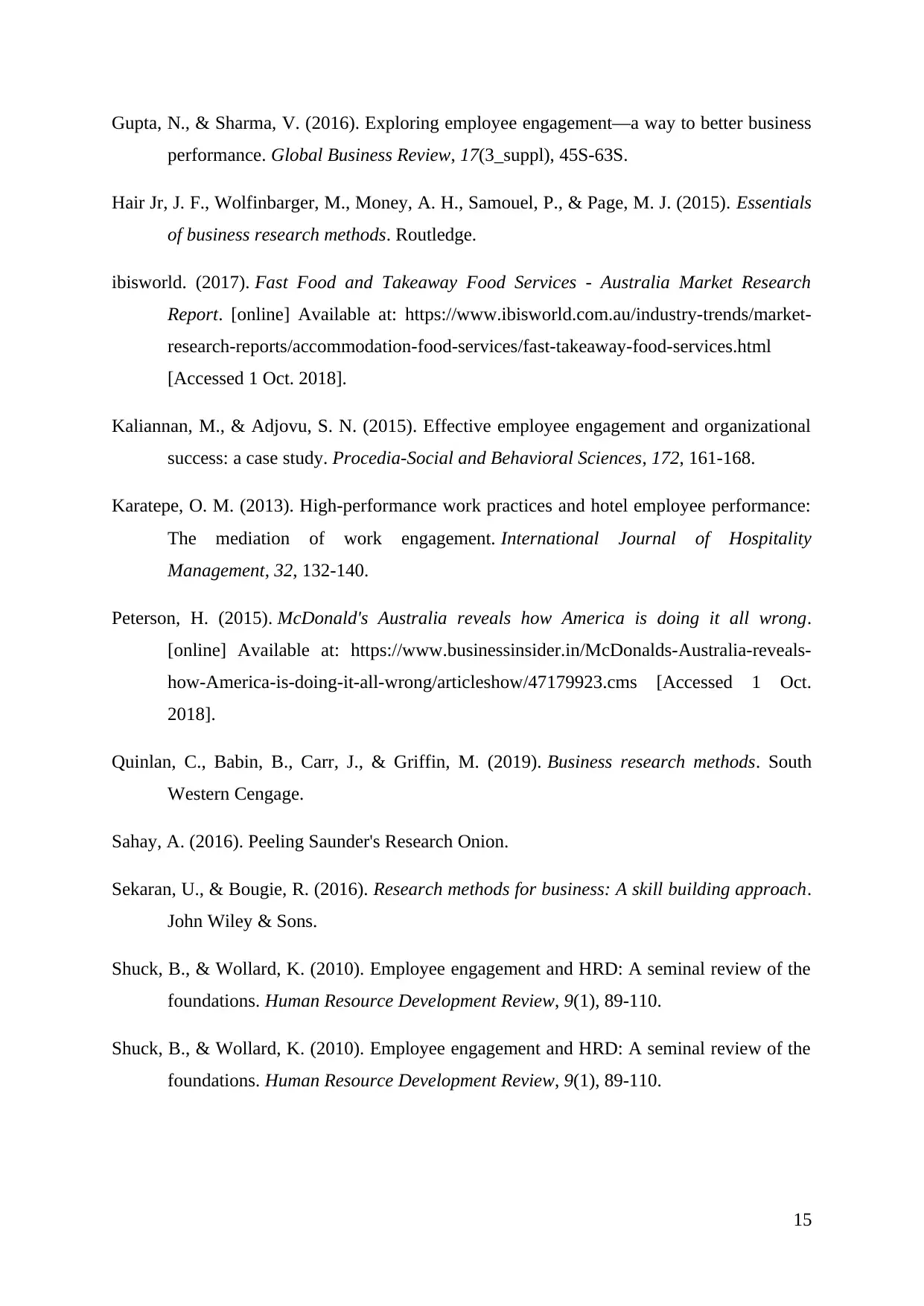
Gupta, N., & Sharma, V. (2016). Exploring employee engagement—a way to better business
performance. Global Business Review, 17(3_suppl), 45S-63S.
Hair Jr, J. F., Wolfinbarger, M., Money, A. H., Samouel, P., & Page, M. J. (2015). Essentials
of business research methods. Routledge.
ibisworld. (2017). Fast Food and Takeaway Food Services - Australia Market Research
Report. [online] Available at: https://www.ibisworld.com.au/industry-trends/market-
research-reports/accommodation-food-services/fast-takeaway-food-services.html
[Accessed 1 Oct. 2018].
Kaliannan, M., & Adjovu, S. N. (2015). Effective employee engagement and organizational
success: a case study. Procedia-Social and Behavioral Sciences, 172, 161-168.
Karatepe, O. M. (2013). High-performance work practices and hotel employee performance:
The mediation of work engagement. International Journal of Hospitality
Management, 32, 132-140.
Peterson, H. (2015). McDonald's Australia reveals how America is doing it all wrong.
[online] Available at: https://www.businessinsider.in/McDonalds-Australia-reveals-
how-America-is-doing-it-all-wrong/articleshow/47179923.cms [Accessed 1 Oct.
2018].
Quinlan, C., Babin, B., Carr, J., & Griffin, M. (2019). Business research methods. South
Western Cengage.
Sahay, A. (2016). Peeling Saunder's Research Onion.
Sekaran, U., & Bougie, R. (2016). Research methods for business: A skill building approach.
John Wiley & Sons.
Shuck, B., & Wollard, K. (2010). Employee engagement and HRD: A seminal review of the
foundations. Human Resource Development Review, 9(1), 89-110.
Shuck, B., & Wollard, K. (2010). Employee engagement and HRD: A seminal review of the
foundations. Human Resource Development Review, 9(1), 89-110.
15
performance. Global Business Review, 17(3_suppl), 45S-63S.
Hair Jr, J. F., Wolfinbarger, M., Money, A. H., Samouel, P., & Page, M. J. (2015). Essentials
of business research methods. Routledge.
ibisworld. (2017). Fast Food and Takeaway Food Services - Australia Market Research
Report. [online] Available at: https://www.ibisworld.com.au/industry-trends/market-
research-reports/accommodation-food-services/fast-takeaway-food-services.html
[Accessed 1 Oct. 2018].
Kaliannan, M., & Adjovu, S. N. (2015). Effective employee engagement and organizational
success: a case study. Procedia-Social and Behavioral Sciences, 172, 161-168.
Karatepe, O. M. (2013). High-performance work practices and hotel employee performance:
The mediation of work engagement. International Journal of Hospitality
Management, 32, 132-140.
Peterson, H. (2015). McDonald's Australia reveals how America is doing it all wrong.
[online] Available at: https://www.businessinsider.in/McDonalds-Australia-reveals-
how-America-is-doing-it-all-wrong/articleshow/47179923.cms [Accessed 1 Oct.
2018].
Quinlan, C., Babin, B., Carr, J., & Griffin, M. (2019). Business research methods. South
Western Cengage.
Sahay, A. (2016). Peeling Saunder's Research Onion.
Sekaran, U., & Bougie, R. (2016). Research methods for business: A skill building approach.
John Wiley & Sons.
Shuck, B., & Wollard, K. (2010). Employee engagement and HRD: A seminal review of the
foundations. Human Resource Development Review, 9(1), 89-110.
Shuck, B., & Wollard, K. (2010). Employee engagement and HRD: A seminal review of the
foundations. Human Resource Development Review, 9(1), 89-110.
15
⊘ This is a preview!⊘
Do you want full access?
Subscribe today to unlock all pages.

Trusted by 1+ million students worldwide
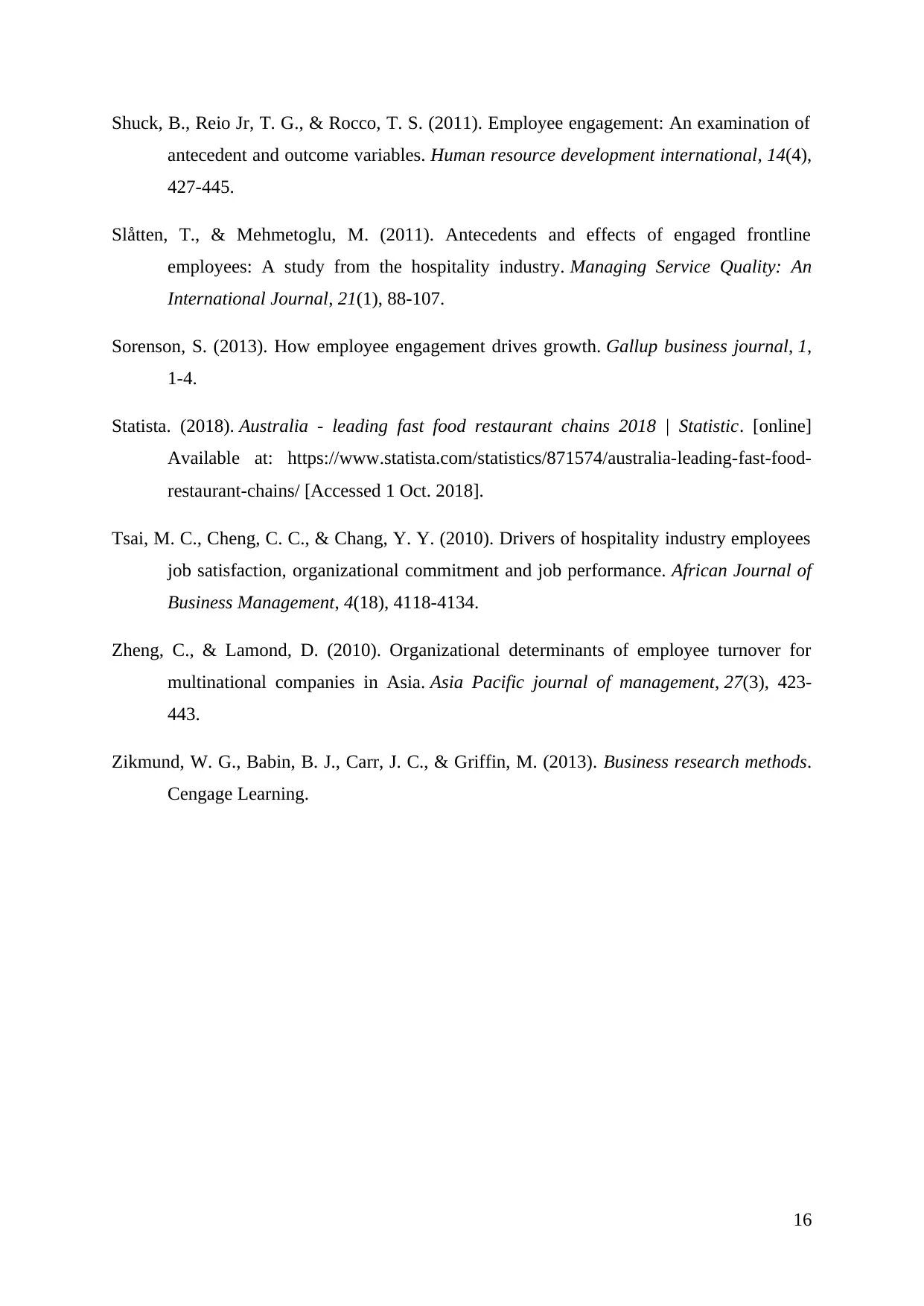
Shuck, B., Reio Jr, T. G., & Rocco, T. S. (2011). Employee engagement: An examination of
antecedent and outcome variables. Human resource development international, 14(4),
427-445.
Slåtten, T., & Mehmetoglu, M. (2011). Antecedents and effects of engaged frontline
employees: A study from the hospitality industry. Managing Service Quality: An
International Journal, 21(1), 88-107.
Sorenson, S. (2013). How employee engagement drives growth. Gallup business journal, 1,
1-4.
Statista. (2018). Australia - leading fast food restaurant chains 2018 | Statistic. [online]
Available at: https://www.statista.com/statistics/871574/australia-leading-fast-food-
restaurant-chains/ [Accessed 1 Oct. 2018].
Tsai, M. C., Cheng, C. C., & Chang, Y. Y. (2010). Drivers of hospitality industry employees
job satisfaction, organizational commitment and job performance. African Journal of
Business Management, 4(18), 4118-4134.
Zheng, C., & Lamond, D. (2010). Organizational determinants of employee turnover for
multinational companies in Asia. Asia Pacific journal of management, 27(3), 423-
443.
Zikmund, W. G., Babin, B. J., Carr, J. C., & Griffin, M. (2013). Business research methods.
Cengage Learning.
16
antecedent and outcome variables. Human resource development international, 14(4),
427-445.
Slåtten, T., & Mehmetoglu, M. (2011). Antecedents and effects of engaged frontline
employees: A study from the hospitality industry. Managing Service Quality: An
International Journal, 21(1), 88-107.
Sorenson, S. (2013). How employee engagement drives growth. Gallup business journal, 1,
1-4.
Statista. (2018). Australia - leading fast food restaurant chains 2018 | Statistic. [online]
Available at: https://www.statista.com/statistics/871574/australia-leading-fast-food-
restaurant-chains/ [Accessed 1 Oct. 2018].
Tsai, M. C., Cheng, C. C., & Chang, Y. Y. (2010). Drivers of hospitality industry employees
job satisfaction, organizational commitment and job performance. African Journal of
Business Management, 4(18), 4118-4134.
Zheng, C., & Lamond, D. (2010). Organizational determinants of employee turnover for
multinational companies in Asia. Asia Pacific journal of management, 27(3), 423-
443.
Zikmund, W. G., Babin, B. J., Carr, J. C., & Griffin, M. (2013). Business research methods.
Cengage Learning.
16
Paraphrase This Document
Need a fresh take? Get an instant paraphrase of this document with our AI Paraphraser

17
1 out of 17
Related Documents
Your All-in-One AI-Powered Toolkit for Academic Success.
+13062052269
info@desklib.com
Available 24*7 on WhatsApp / Email
![[object Object]](/_next/static/media/star-bottom.7253800d.svg)
Unlock your academic potential
© 2024 | Zucol Services PVT LTD | All rights reserved.





